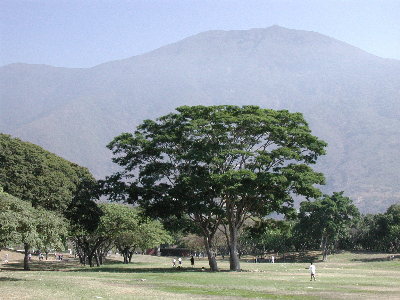1. Birding
Caracas
(also: 2. Coastal Cordillera: El Avila)
Visiting birders usually opt to avoid Caracas or to
leave as swiftly as connecting flights or hire car agencies
permit. Nevertheless, the city does offer some good
birding sites at which one can easily spend an enjoyable
day or two. So for the intrepid, or those limited to
birding the capital during a business trip, here follow
a few thoughts. In addition, more on birding El Avila
can be found in the next section.
Caracas is well blessed with trees and, together with
the oases of metropolitan parks, this probably helps
maintain good populations of birds in the city. As testimony
to this, in recent years Venezuelan Audubon Charity
Birdathons have clocked close on 100 species during
a morning’s outing. Chief among the city’s
green areas are Parque del Este and the Jardín
Botánico (Botanic Gardens), both of which can
be visited by Metro via the stations of Parque del Este
and Plaza Venezuela respectively.
Parque del Este offers open parkland habitat with several
ponds and lakes. The park opens at 5.00 am and it is
wise to get there early before the crowds arrive and
the day heats up. Typically Chestnut-fronted Macaws
and Orange-winged Parrots call raucously as they leave
their roosts together with the introduced Ring-necked
Parakeets. A Ferruginous Pygmy-Owl can usually be called
out of one of the stands of trees and the song also
serves as an attractant for other species. Stripe-backed
Wrens inhabit the large trees bordering grassy areas.
Wetland patches hold Wattled Jacanas, Black-crowned
Night-Herons and Yellow-hooded Blackbird. Rufous-vented
Chachalacas are usually abundant. Copper-rumped Hummingbirds
can be found visiting blooming trees while Trinidad
Euphonias sing from treetops.

Photo: Parque del Este with the Avila behind (Chris
Sharpe)
The Jardín Botánico holds a similar selection
of species to Parque del Este, but its extensive deciduous
forests are also home to Mouse-coloured Tyrannulet and
Fulvous-headed Tanager and there is often a better chance
here for Trinidad Euphonia and Black-faced Grassquit.
On the outskirts of the city several other sites are
accessible as part of a day tour. The Universidad Simón
Bolívar campus on the southern outskirts holds
a typical city avifauna similar to that of Parque del
Este, but adjoining cloud forests can add a few extra
species. Parque Vinicio Adames at 1150 m altitude on
the edge of the motorway which exits Caracas towards
Maracay is an altogether more rewarding area. Black
Hawk-Eagle, Lilac-tailed Parrotlet, Copper-rumped Hummingbird,
Collared Trogon, Groove-billed Toucanet, Scaled Piculet,
Stripe-breasted Spinetail, Olivaceous Woodcreeper, Plain
Antvireo, Fulvous-headed Tanager, Black-headed Tanager,
Swallow Tanager, Trinidad Euphonia and Black-faced Grassquit
are all regular. There is a particularly good stretch
of forest at the top end of the park beyond the games
court.
A little further a field Turgua, beyond the Universidad
Simón Bolívar, provides true cloud forest
birding, though the habitat along the road has become
very fragmented now. Birding is somewhat similar to
Parque Vinicio Adames and typical species include Black
hawk-Eagle, Collared Trogon, Scaled Piculet, Golden-breasted
Fruiteater, Black-hooded Thrush, Fulvous-headed Tanager,
Black-headed Tanager, Swallow Tanager and Ochre-breasted
Brush-Finch.
A vast range of accommodations for all tastes is to
be found in Caracas. The Hotel Avila in San Bernardino
is particularly pleasant as its grounds provide a nice
introduction to neotropical birding.
Specialities and endemics (E = endemic; S = semi-endemic)
Rufous-vented Chachalaca S
Band-tailed Guan S
Blood-eared Parakeet E
Venezuelan Parakeet E
Lilac-tailed Parrotlet S
Copper-rumped Hummingbird S
Groove-billed Toucanet S
Scaled Piculet S
Crested Spinetail S |
Golden-breasted Fruiteater S
Venezuelan Tyrannulet S
Stripe-backed Wren S
Black-hooded Thrush S
Trinidad Euphonia S
Fulvous-headed Tanager S
Black-faced Grassquit S
Ochre-breasted Brush-Finch S |
Full bird checklist
None available.
(see also: 2. Coastal Cordillera:
El Avila)
|